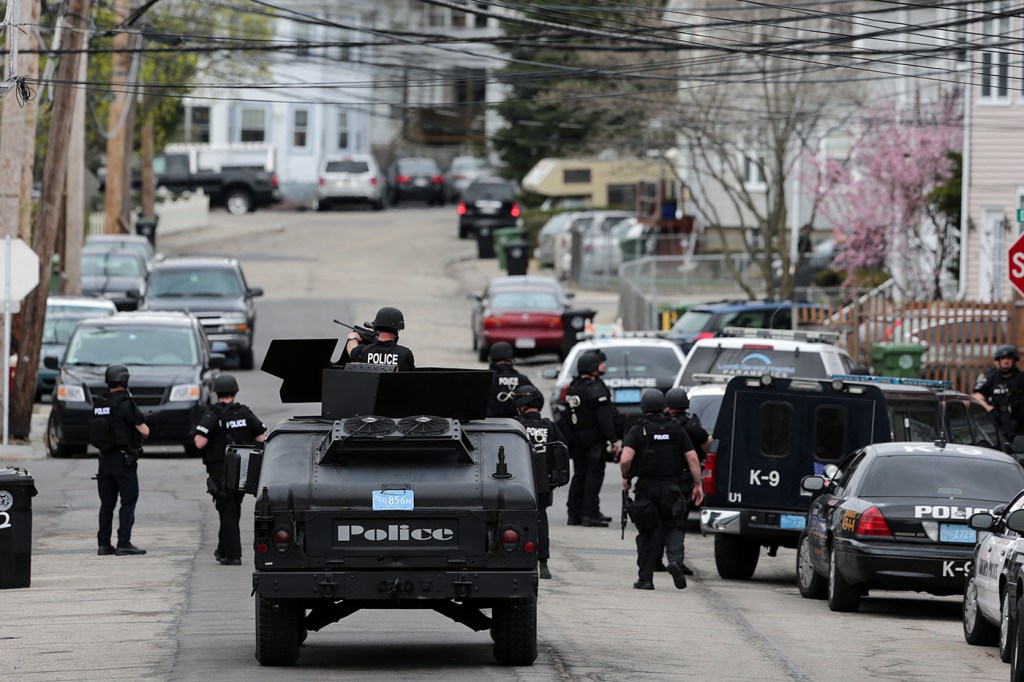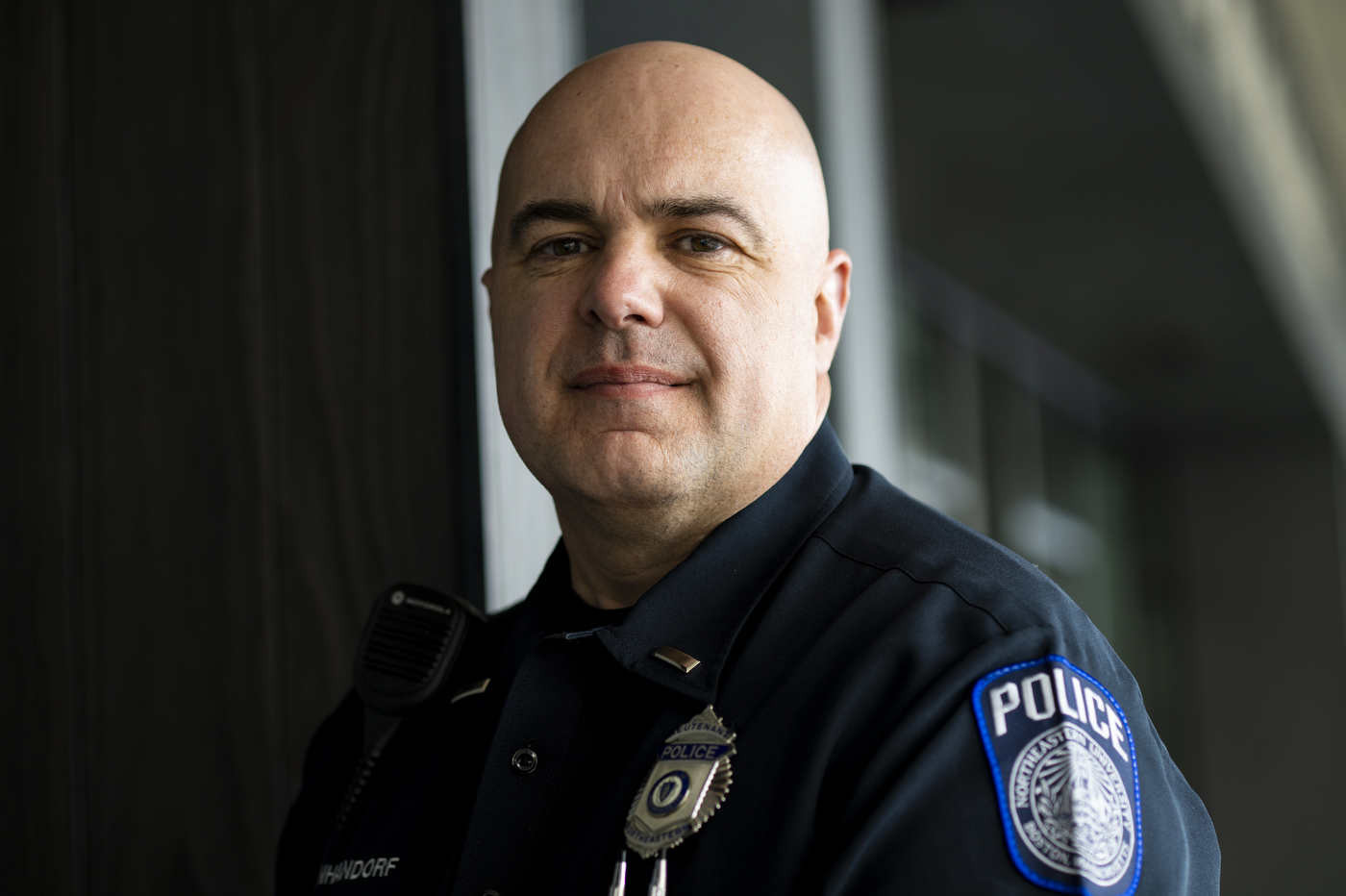‘I don’t want to ever see what I just saw ever again.’ 10 years later, Northeastern police officers reflect on manhunt for Boston Marathon bomber

By Thursday night, April 18, 2013, officers Chris VonHandorf and Tim Flynn had spent four days deployed in Boston as part of the regional SWAT team Metro Star. They’d guarded hotels and hospitals and fielded suspicious package reports, at a time when no suspects in the marathon bombing had been identified, and no one knew if the terrorists would strike again.
At last, VonHandorf and Flynn—now a lieutenant and a sergeant at Northeastern—each went home and settled down for a good night’s sleep.
Then their wives woke them up.
“She rocked me awake and was like, ‘Tim, an officer was killed at MIT. You’ve gotta go,’” Flynn recalls.
From their homes south of Boston, Flynn and VonHandorf each drove to Boston Common, their staging area that week. From there, they were deployed to Watertown in the early hours of Friday, April 19. An armored car brought VonHandorf to Laurel Street, just hours after the middle-of-the-night firefight and explosives battle there between Tamerlan and Dzhokhar Tsarnaev and several police officers.
“We opened the door, and all I can smell is gunpowder,” VonHandorf recalls. Then he noticed a second scent, “more like that explosive-type smell.” He recognized a member of the Massachusetts State Police bomb squad, who warned him: “Be careful where you step. There’s a lot of unexploded ordnance around.” About 40 yards away, VonHandorf saw the police cars that had been involved in the firefight.


All that long day, VonHandorf and Flynn each took part in the Watertown manhunt for Dzhokhar Tsarnaev.
Flynn walked hilly streets in Watertown, carrying an AR-15 rifle and a pistol, “not knowing what was going to present itself, either hiding in a bush, or under a porch, or in a backyard.” Often he stood guard on the sidewalk while other SWAT team members searched behind houses.
“Every team got a Bearcat, which is the armored car,” VonHandorf recalls. “We’d have a sniper up top providing cover all the way down the street. We’d have three or four officers on one side of the street, three or four officers on the other side. And we would just work methodically down the street. Sometimes I would be in a backyard. Sometimes I’d be closer to the street.”
As evening neared, Gov. Deval Patrick lifted the day’s shelter-in-place advisory. Word came by radio to end the day-long Watertown search. After a debriefing at the police staging area at Arsenal Yards, VonHandorf and Flynn headed home.
“I got home, we were watching the TV, and they’d said that they found something in a boat,” Flynn recalls. A Watertown resident had gone into his backyard, noticed the covering to his boat ajar, peered inside, and seen Dzhokhar Tsarnaev lying inside near his own bloodstains. Police surrounded the boat, fired grenades and weapons, and convinced Tsarnaev to surrender at about 8:45 that night.
When the news reported the street that the boat was on, Flynn Googled it. “That was the next street over from the last street that we had searched,” he says. It felt eerie. “If they’d given us 10 or 15 more minutes, we may have been able to discover him,” Flynn said. “I think it would’ve been satisfying to be the one that found him.”
Ten years later, Flynn and VanHandorf both say the experience of the marathon bombing compelled them to change their career paths in policing. VanHandorf left the city of Dover police in 2018, and Flynn left the Norfolk County Sheriff’s Office in 2019, to come to Northeastern.
Just hours after the marathon bombing, VonHandorf had gone to Boylston Street and seen the aftermath.
“I was horrified,” he recalls. “You could tell that there was devastation.”
He says the bombing changed his purpose as a police officer.
“I don’t want to ever see what I just saw ever again,” he recalls thinking.
After years of SWAT-team preparation and response, VonHandorf changed his focus to preventing attacks.
“Part of the reason why I came to Northeastern is built around prevention,” he says. “We’re very good in policing about preparedness and response. Prevention” — which he defines as building security through people, processes, and technology — “has been a very key aspect of these last 10 years: a lot of reflection, a lot of studying, a lot of seeing what works.”
As for Flynn, watching surveillance video of the Tsarnaev brothers at the marathon led him to a new focus.
“The Tsarnaevs, their attention was different,” Flynn says. “You could see that their motivations were different than everyone else that was at the marathon. It got me very curious about how people behave and behavior detection.”
Since then, he’s attended several trainings on behavior detection: “how people do things and why.” He now teaches a behavior detection class to his fellow Northeastern police officers.
“So it’s really that, 10 years ago, that has molded some of my career today,” Flynn says.






